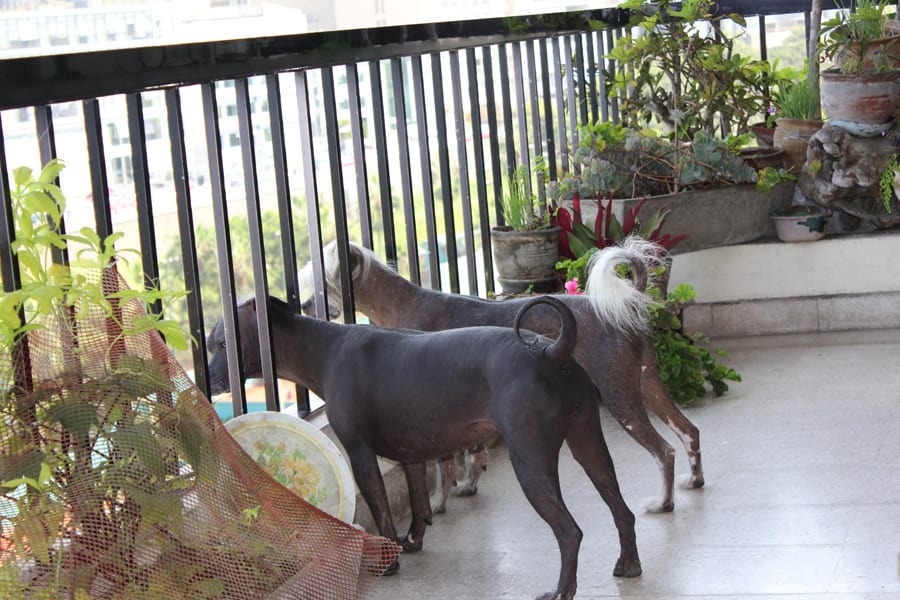By Andrew Kolasinski
Inside there will be shade and coolness promised by the pools of the royal chambers. But it is scorching hot at the entrance to the ruins of Chan Chan, the ancient adobe city. Adding to the discomfort is the yapping dog. It won’t stop barking. As long as visitors keep arriving, the little dog maintains his noisy vigilance. Some of my fellow tourists are getting annoyed. One man in straw cowboy seems particularly aggravated. He throws a stone at the nuisance, but misses his target. “I read in a guidebook that most of these stray dogs have rabies,” he tells us while picking up another stone. Donna, our previously patient and tranquil tour guide steps in and grabs his arm before he can fire his second missile at the dog. “No senior,” she scolds, “This is not a stray dog. No rabies. He is the guardian of the temple.”
It is a Peruvian Hairless (Perro sin pelo del Peru), the dog of the Incas, and it nearly became extinct. Peruvians are understandably protective of them.
As the name suggests they are bald. Even stranger, their smooth skin is usually black, though some tend towards brown. Crown this body with a bright orange Mohawk-style ruff on the top of their heads and another orange plume at the tip of the tail, and you’ve got a very distinct canine.
They’re not big dogs, but do come in three sizes: small, medium and large, between 4 kilograms and 25 kilograms (9 to 55 pounds).
Other than their unique appearance Peruvian Hairless have some singular characteristics.
They have the highest body temperature of any canine. Their skin exudes lanolin which is a soothing oil that protects and heals human skin. In Inca times dogs were put into bed with sick or injured people. In the high Andes a warm dog is a useful companion. They are also credited with being beneficial in the treatment of asthma, arthritis and other illnesses.
Having no hair they do not get fleas, but they do get cold. Their owners wrap them in blankets in the chill mountain nights. They are known to get attached to their blankets, moving their bedding as it suits them.
Aside from their health benefits they are affectionate pets. They are however very suspicious of anyone they don’t know and bark incessantly at strangers. This characteristic made them a valuable ally for isolated mountain households where advance warning of intruders could be lifesaving. As guard dogs they are vigilant.
There are depictions of these dogs dating back over 3,000 years on murals and in pottery from ancient Peruvian cultures. Mummified Peruvian Hairless Dogs have been found reposing among their mummified owners.
Despite this long history the Peruvian Hairless came close to extinction. The Spanish Conquistadors staged fights between Peruvian Hairless Dogs and huge European Mastiffs. The outcome was predicable; the native dogs were ripped to shreds by the Spanish war dogs. It became unfashionable for Peruvians to keep their hairless dogs as pets and many were turned out. Most of the remaining ones roamed wild.
Interbreeding with other dogs was diluting the species and by the mid-twentieth century there were few pure specimens. Luckily they have had a comeback in recent years.
In 2008 Peruvian Hairless Dogs achieved world celebrity when American President Barrack Oban was offered a puppy by the Association of Friends of Hairless Dogs of Peru as the official first family dog at the White House. The President’s children are allergic to pet dander and this breed is also dander free. The pup was named Machu Picchu.
The Federation Cynologique Internationale, which catalogues the world’s purebred dog species, recently recognized the Peruvian Hairless. Other dog authorities are following suit, and there is speculation that these unique animals will one day win top honors at the Winchester Dog Kennel competition.
In 1989 the directors of the Huaca Pucllana archeological site in Lima brought in a pair of hairless dogs as guards. The Peruvian government has since ordered all archeological sites to keep a pair, and the future of the breed is promising.
Born in The Hague, Andrew Kolasinski arrived in Canada as a small child riding in the luggage rack of a DC-7. Since then he has felt at home anywhere. As the publisher and editor of Island Angler, Andrew spends half the year fishing for salmon and trout, and in the off-season he travels the world looking for a story. This article was written on behalf of Aracari Travel, leaders in providing cultural tours throughout Peru.
###
Contact: Maureen Santucci
If you would like to submit a guest post on food, wine or travel to Where and What in the World, I would be happy to feature your travel experience , drink, special wine tasting, or family or simply delicious recipe. If you go to submission tab, you will see how to submit, as well as have the opportunity of telling me if you would like to would like to be a regular contributor. When uploading a file for submission, you are also able to upload jpgs. Please feel free to put a last paragraph about you and a link to your profile. No html please. You can also include a head shot.















